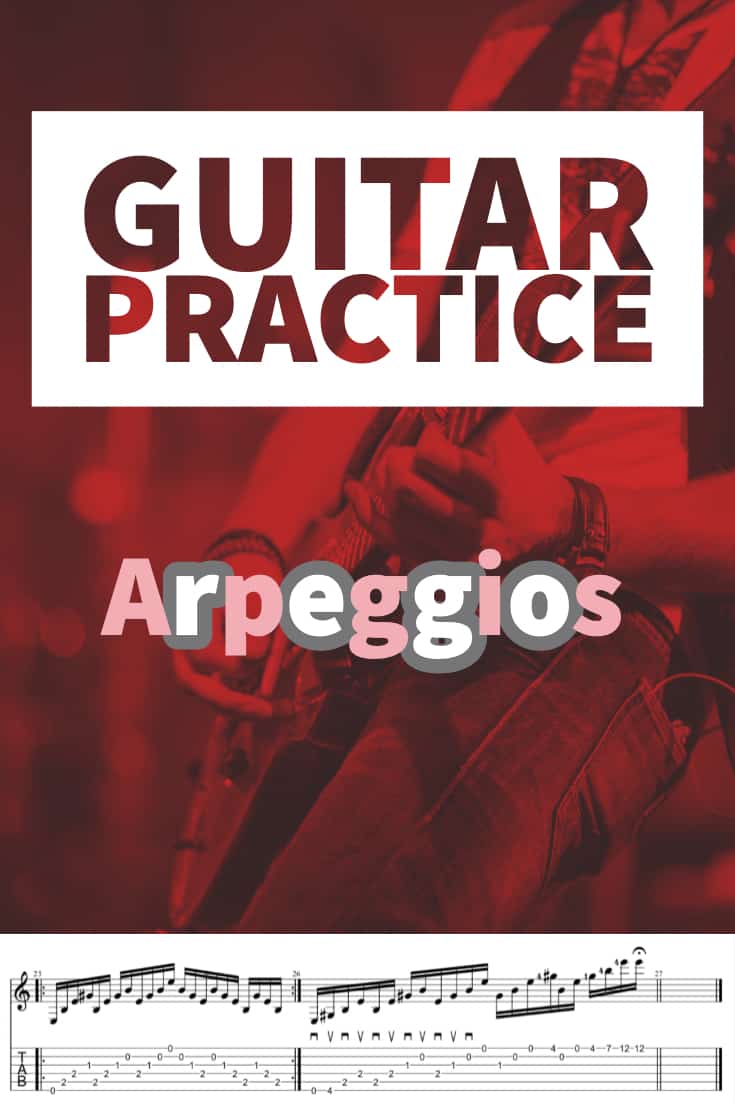Hey, it’s Arpeggio day! In this lesson we’re going to change it up by doing some Guitar Arpeggios and sequences for guitar. You can grab these guitar arpeggios in PDF, TAB, or download below. If you missed the first 2 installments of the guitar practice routine, you can find them here:
7 Day Guitar Practice Routine: Day 1 – Warmups
7 Day Guitar Practice Routine: Day 2 – Modal Workout
Guitar Arpeggios Table of Contents
If you’re new to the guitar practice routine, I highly recommend reading the first one that includes important instructions on how to practice the right way every time you pick up a guitar.
UPDATE: The Full Book is Done! Read The Reviews Here

Guitar Routine #2, The Modal Workout delves a bit deeper into some basic scale theory that every guitarist should know. Consequently, you can assign an arpeggio to each mode or scale tone in any key.
Otherwise, if you think you’re ready, lets get right to it!
Guitar Arpeggios FAQ (Updated 2024)
What are guitar arpeggios?
On Guitar or any other instrument, an arpeggio is the sounding of the notes of a chord in succession rather than simultaneously. Also referred to as arpeggiation.
What arpeggios should I learn first?
Major, minor, diminished, and some other diatonic arpeggios in this lesson are a great place to start.
How do I arpeggiate on the guitar?
By picking each note in a chord individually, whether with a pick or your fingers.
How many guitar arpeggios are there?
Literally thousands! The number of shapes are seemingly endless, but certainly 3-5 of each arpeggio type (major, minor, etc.) would be more than the average pro-level guitarist.
Diatonic Triads – G String Root
Before we get into the big & meaty arpeggio shapes, we’re going to start off with some simple triads. This lesson will be in the key of C Major/A minor.
Whether you’re a beginner or more advanced player not familiar with these shapes, take a strum through them first without the picking sequences.
Diatonic Chords & Arpeggios in C Major:
- C Major – CEG
- D minor – DFA
- E minor – EGB
- F Major – FAC
- G Major – GBD
- A minor – ACE
- B diminished – BDF
Guitar Arpeggio’s – Triads
Starting in the 2nd position with A minor, we’re going to do a simple ascending in addition to descending alternate picking sequence through all of the arpeggios.
This first set will only include triads with the root notes on the G String:
- Alternate pick through the triads starting on the A note (2nd fret, G String), while also continuing through all of the arpeggios up the neck.
- If these triads feel even a little uncomfortable, go ahead and repeat each one 2-4x before switching to the next one.
- In an ascending triplet feel we’re changing the picking to – DOWN, DOWN, UP.
- In a descending triplet feel, switch to – UP, UP, DOWN.
- Set # 4, “Double-pick” each note in each arpeggio ascending and descending.
- Use a Metronome!

Diatonic Triads – D, A & E String Root Guitar Arpeggios
You can probably see where I’m going with this right? We’re going to do the exact same 4 sets, but move the triads “down” to the D string shapes.
- Starting on the E note (2nd fret, D String), build your arpeggios diatonically up the neck in the key of C Major.
- Do the same thing starting on the B (2nd fret, A string) and the G (3rd fret, low E string).
- For the purposes of this article, I’ll avoid the redundancy of putting all that repetitive music here.
Get on my email list to be the first to get the FULL BOOK when it’s finished next month.
Thoughts on Sweep Picking Guitar Arpeggios
Ahhhh, sweep picking. Most guitarists either love it or hate it. I’m kind of on the fence really. I mean, if I see someone doing it well and in a tasteful manner, it is cool. Furthermore, some of my favorite 80’s guitarists featured this technique prominently.
Most of the time though, it’s out of place in just about any style of music outside of Progressive, Fusion or 80’s era Metal Styles.
Sure there are a million YouTube Guitar Nerds out there blazing away in their bedrooms, but it just doesn’t fly in real life professional playing situations. It’s a fantastic way to get fired from a corporate gig…not that I would know 🙂
It just seems silly outside of the Metal genre. Sure, you’ll impress someone with it. It’s flashy and sounds incredibly difficult when executed properly.
My Opinion On Arpeggios
If you haven’t gotten the other, more important facets of your playing together ie,. Chords, Rhythm, bending, good note choices etc., al. It seems kind of silly to be over-using this advanced technique.
……and the good:
Now, as for the merits of Sweep picking… let’s talk about the wonderful side benefits such as syncing the hands. It really helps! Sweep picking is also wonderful for your upstrokes.
Sweep picking big 5 string arpeggios shapes also greatly benefits your fretting hand strength and dexterity. Regardless of your own personal opinion on this technique, the exercises below will benefit both hands greatly. Just don’t be… that guy. (Or gal)
That being said, if you’re a Metal Guitarist and assuming you’re playing in a Metal band, ignore everything I just said and just SHRED. 🤘
Craig’s Top 5 Classic Shred Guitar Albums (Tasty Picks!):
- Jason Becker – Perpetual Burn
- Racer X – Second Heat
- Vinnie Moore – Mind’s Eye
- Greg Howe – Greg Howe
- Yngwie J. Malmsteen’s Rising Force – Marching Out
5 String Diatonic Guitar Arpeggios
This first set consists of an A String root, 1 note per string except for 2 notes on the high E. These are the most common “shredder” era shapes not to mention, easy to get your hands around.
The real challenge here is the picking. Notice when doing the C Major shape below, the picking changes on the second run.

Essentially you’re “sweeping” ascending with all downstrokes. You’re hitting that pull-off with an upstroke, sweeping descending with upstrokes, THEN.. starting on a downstroke on the D String.
It’s tricky but worth the effort.
Once you’re comfortable with that, here’s a sequence utilizing more arpeggios in the Key of C Major.
For this one I like to add an extra low note (the 5th) on the A string to each arpeggio. This gives it a nice flow for playing them in time with a 16th (or 32nd) note feel.
Here’s a few more arpeggios using this extra low 5th pattern:
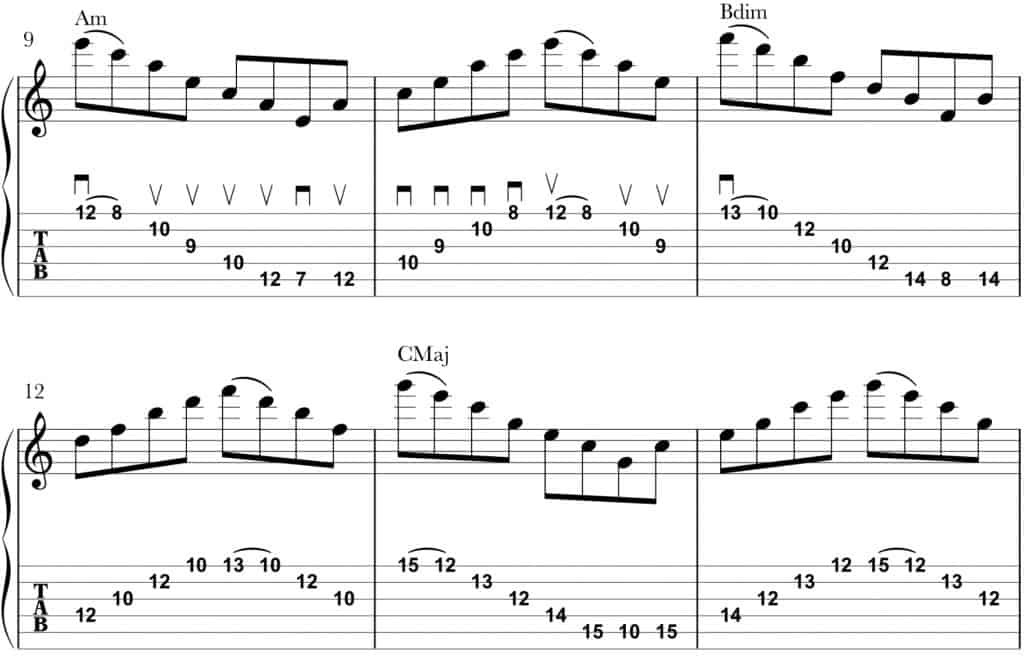
You can tweak that out any way you like. They are a lot of fun, so happy shredding!
Diatonic 7th Guitar Arpeggios
These are really the meat & potatoes of my improvising tools, in addition to just sounding great . Along with Modal scales, Diatonic 7th Arpeggios provide an excellent framework for improvising in just about any music style.
They can sound a little jazzy or a little shreddy because of the note order. Furthermore, some can even sound Bluesy. They just work everywhere in addition to giving your solos a really sophisticated and focused sound. They sound cool without the cheesy “shred” stigma, just in case you’re trying to avoid that. (ahem)
To explain in more detail, all we’re doing here is adding that 7th scale degree to the existing (1,3,5) arpeggios we did above. If it helps to make the association with modes, hey whatever works for you. In other words, you could think of it like this. (chord/arpeggio tones highlighted red)
- C Ionian: C D E F G A B C – C Major 7
- D Dorian: D E F G A B C D – D minor 7
- E Phrygian: E F G A B C D E – E minor 7
- F Lydian: F G A B C D E F – F Major 7
- G Mixolydian: G A B C D E F G – G Dominant 7
- A Aeolian: A B C D E F G A – A minor 7
- B Locrian: B C D E F G A B – B minor 7b5
7th Arpeggio Shapes:
Another key point that I’d like to share is that I find it easier to memorize these in different places by thinking of a “behind the root” and “in front of the root” shape. The way the neck is laid out, guitar arpeggios (like scales) can be played in different shapes using the same notes.
For example, these Dm7 (ii in C) shapes below:

In the 5th position starting on the (D) note you can take that Dm7 arpeggio in either direction on the neck. Of course, you can map out your own shapes just about anywhere you want, but I prefer shapes with the root on the (A) String.
You can use the above shapes for the 2nd, 3rd and 6th degrees of the Key. For the Key of C that would be: Dm7, Em7 and Am7.
I like to mix the 2 shapes together like this:
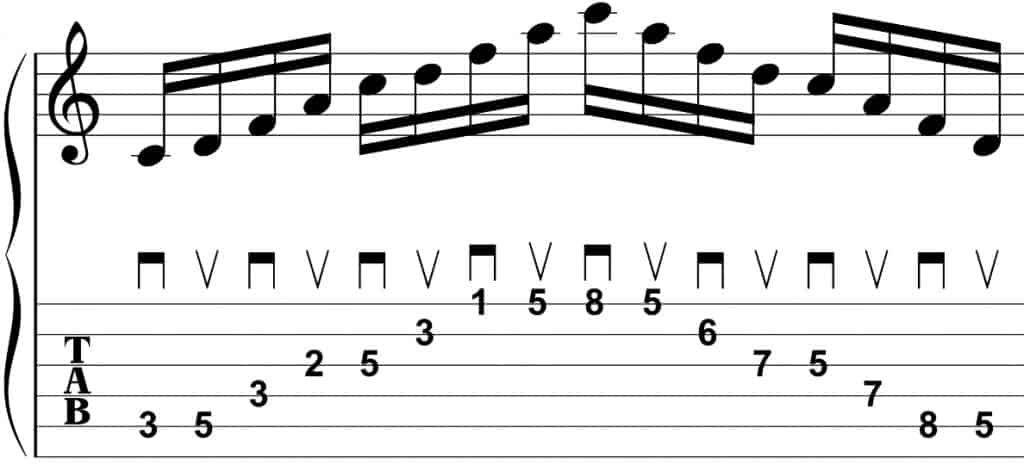
Starting on the 3rd fret (C note, 7th of Dm7) alternate pick ascending through the arpeggio shifting at the top and descending in the “in front of the root” shape. This is a particularly great technique for coming up with some tasty licks in your improvisations.
Major 7th Guitar Apeggios
You can also use the below sequence/shape for the I and IV of every key. In this case: C Major7 or F Major7.
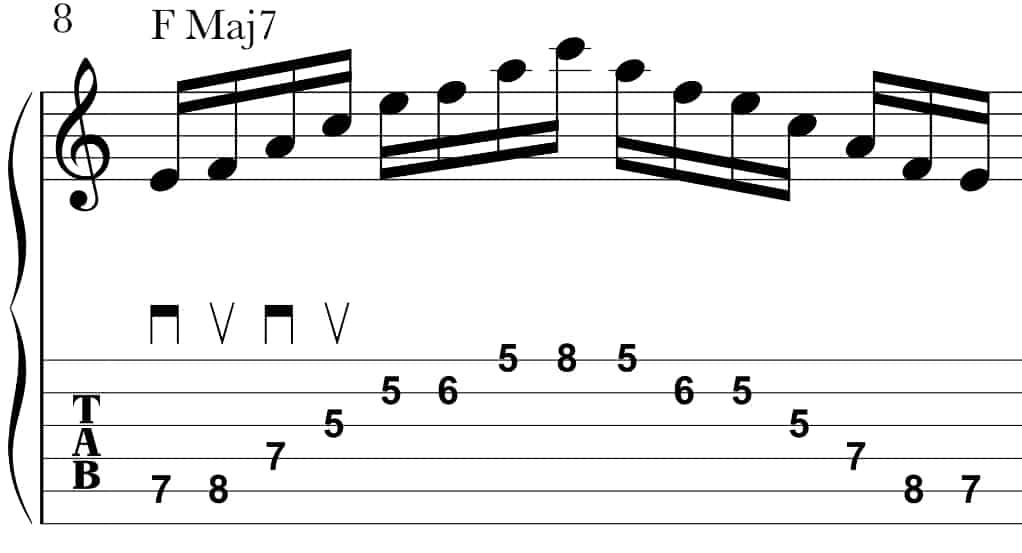
Using C Major7, here’s a different shape covering all 6 strings.
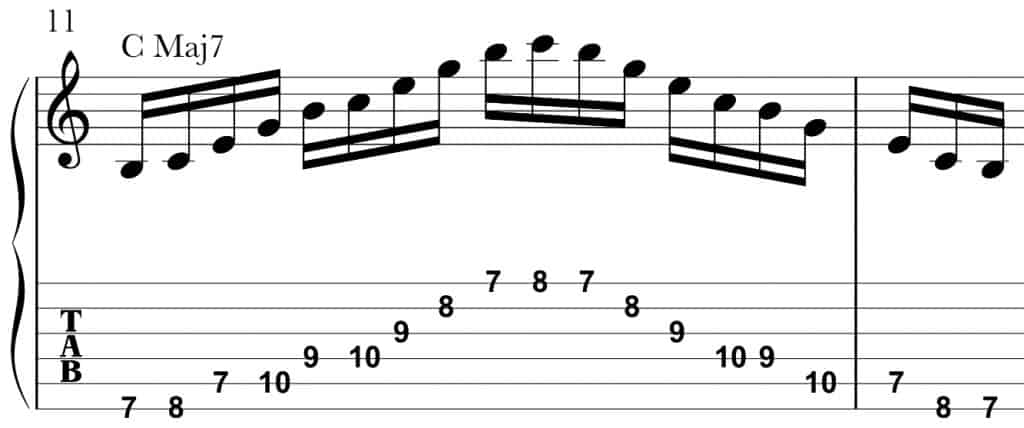
The V and VII
Remember, the 5th chord/arpeggio of any key is a Dominant 7th. To clarify, it’s just a Major chord with a flat 7th added. In the Key of C Major, the V chord is G7. These dom7 guitar arpeggios feel a lot like pentatonic scales.
G7 behind the (A) string root:
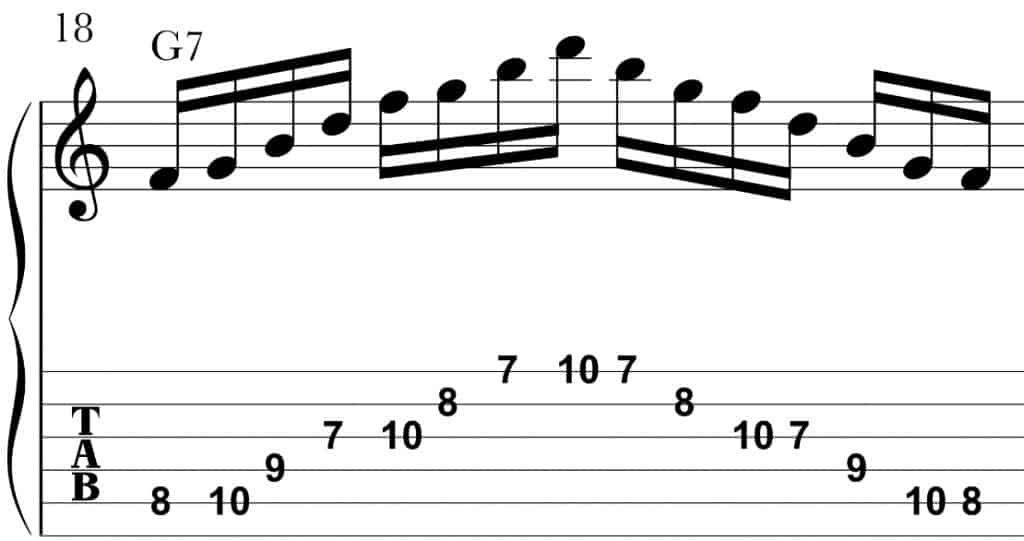
I’ve always liked this one across 6 strings. It reminds me of some bluesy and jazzy guitarists, most notably, Eric Johnson. Also, don’t forget to alternate pick!
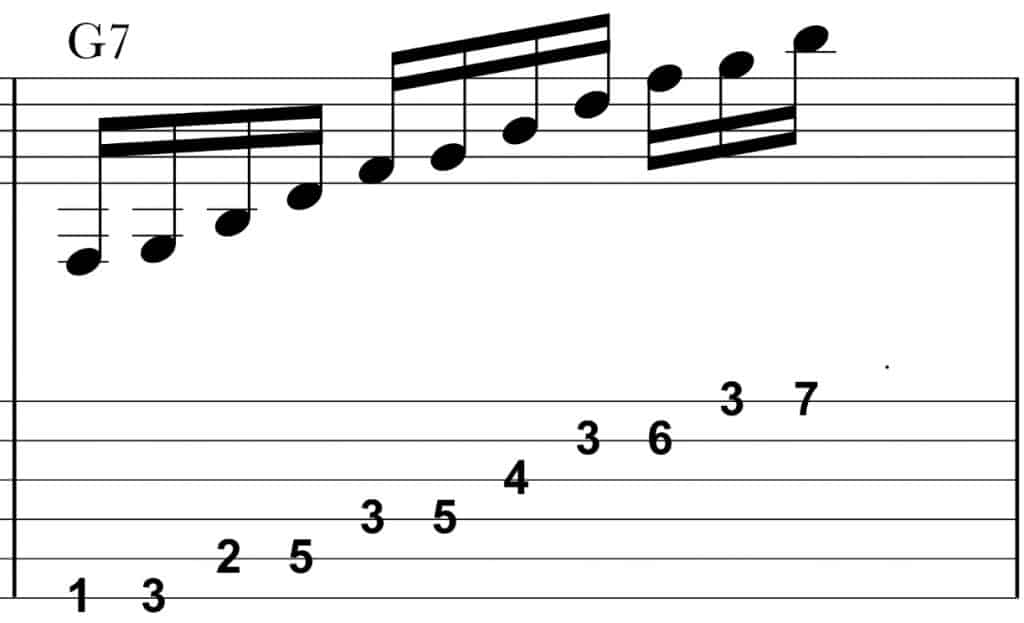
For the VII of every key you’ll use the minor7b5 arpeggio on the (B) note. The m7b5 is also referred to as 1/2 diminished. In addition, this arpeggio really exploits that dark diminished/Locrian sound.
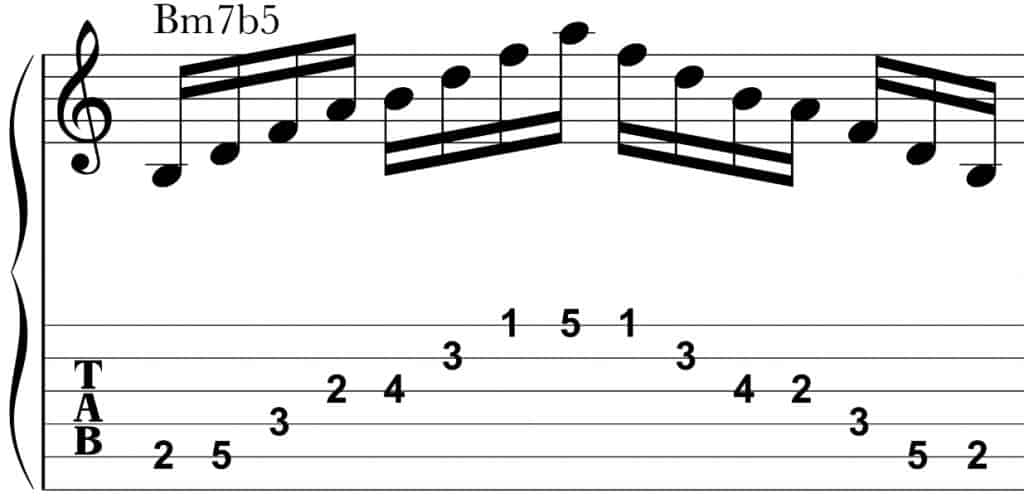
Some Guitar Arpeggios Usage and Analysis
Moreover, 7th arpeggios can give you a wide array of sounds. You can play them with a Key Center approach by just mixing and matching sequences you like. They ALL work in the key regardless of what the chord progression is (assuming the chords are in the Key of C).
You can also use them for a more focused sound. For example, playing an Am7 arpeggio over a Dm7 chords gives you a D minor 11th sound. Jazzy right?
Am7 = ACEG
To explain further, In relation to D those notes would relate as:
A – 5th of D
C – b7 of D
E – 2nd or 9th of D
G – 4th or 11th of D
With this type of approach, you’re kind of forcing the listener into a certain sound by superimposing one chord/arpeggio over another in the same key.
You can go nuts with that little nugget of info and try different combos that sound good to you.
More Arpeggio Tips
Think of the lines and spaces on the Treble Clef when memorizing the notes in arpeggios.
For example, the spaces:
F-A-C-E… Hey, that’s an F Major 7!
The lines starting on E:
Remember that saying when you were a kid?
EVERY GOOD BOY DOES FINE
E-G-B = Em
E-G-B-D = Em7
E-G-B-D-F = Em9
Pretty cool right? I know it helps me in times of doubt (or too many beers).
- If you haven’t read my previous articles, I can’t stress it enough. Always practice with a metronome.
- Watch your picking hand.
- Practice with both clean and distorted tones.
- Try playing guitar arpeggios sweep picking as well as alternate picking styles.
- To explain further, I also wrote another article on guitar arpeggios & sequences.

Craig Smith is a professional Guitarist, Teacher, and Writer living in Sanford, Florida. Craig has taught guitar lessons, performed 200+ gigs per year for nearly 30 years, and published 4 guitar instructional books. When he’s not gigging or writing, you may find him by the pool with his wife Celeste, 4 Chihuahuas, and a drink. 🎸
